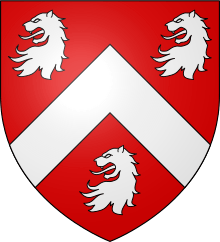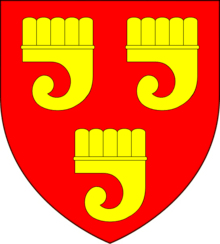Duke of Albemarle
The Dukedom of Albemarle (/ˈælbəˌmɑːrl/) has been created twice in the Peerage of England, each time ending in extinction. Additionally, the title was created a third time by James II in exile and a fourth time by his son the Old Pretender, in the Jacobite Peerage. The name Albemarle is derived from the Latinised form of the French county of Aumale in Normandy (Latin: Alba Marla meaning "White Marl", marl being a type of fertile soil), other forms being Aubemarle and Aumerle. It arose in connection with the ancient Norman Counts of Aumale of Aumale in Normandy. See also Earl of Albemarle.
Dukes of Albemarle (Aumale), first Creation (1397)
- Edward of Norwich, 1st Duke of Albemarle (1373–1415), grandson of Edward III, was deprived of this dukedom in 1399. He later succeeded his father as Duke of York.
Dukes of Albemarle, second Creation (1660)

Arms of Monck: Gules, a chevron between three lion's heads erased argent
- also Earl of Torrington, Baron Monck of Potheridge, Beauchamp and Teyes (England, 7 July 1660)
- George Monck, 1st Duke of Albemarle (1608–1670) was rewarded with his peerages for his part in the Restoration.
- Christopher Monck, 2nd Duke of Albemarle (1653–1688), only son of the 1st Duke, died childless.
Dukes of Albemarle, first Jacobite Creation (1696)
- also "Earl of Rochford" and "Baron Romney" (Jacobite, 1696)
- Henry FitzJames, "1st Duke of Albemarle" (1673–1702), illegitimate son of James II was created a peer by his father in exile
Dukes of Albemarle, second Jacobite Creation (1722)

Arms of Granville: Gules, three clarions or
- also "Marquess Monck and Fitzhemon", "Earl of Bath", "Viscount Bevil" (Jacobite, 1722), Baron Lansdowne (Great Britain, 1712) and "Baron Lansdown of Bideford" (Jacobite, 1722)
- George Granville, 1st Baron Lansdowne, "1st Duke of Albemarle" (1666–1735), a notable Tory, was made a Jacobite peer by The Old Pretender, which creation was not recognised within the Kingdom of Great Britain.
- Bernard Granville, "2nd Duke of Albemarle" (1700 – 2 July 1776), nephew of Lord Lansdown, allegedly[1] succeeded his uncle in said Jacobite peerage.
Notes
- ↑ Bernard Granville, Duke of Albemarle at thepeerage.com (accessed 29 February 2008)
References
- Cokayne, George E. (1910). Gibbs, Vicary, ed. The complete peerage of England, Scotland, Ireland, Great Britain and the United Kingdom, extant, extinct, or dormant. I, Ab-Adam to Basing. London: St. Catherine Press. pp. 87–91.
- Cokayne, George E. (1998). Hammond, Peter W., ed. The complete peerage of England, Scotland, Ireland, Great Britain and the United Kingdom, extant, extinct, or dormant. XIV, Addenda and Corrigenda. London: St. Catherine Press. p. 17.
This article is issued from
Wikipedia.
The text is licensed under Creative Commons - Attribution - Sharealike.
Additional terms may apply for the media files.